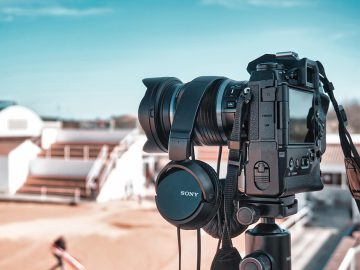Scammers have tried to deepfake high profile football and media personality Eddie McGuire in an advertisement on YouTube.
McGuire has confirmed the advertisement, which the ABC has seen, used footage from a commercial television appearance with a voiceover impersonating him.
It claims to offer a lucrative investment opportunity, with a QR code appearing on the screen.
The voice wavers in and out of an American accent, sometimes sounding more authentic before veering back into a US-style voiceover.
“It looks to be something where you put up your phone to a QR code, and then they’ll get access to your phone, so it’s quite sophisticated,” McGuire told ABC Radio Melbourne.
The quality of the deepfake video differs, from sometimes looking and sounding like the real deal, to being more obviously manipulated. (Supplied)
He said people who saw the video on their mobile phones or small screens might be caught out by the scam.
“The voice is reasonable,” he said.
“I’ve got a reasonably distinctive voice, you know, Glasgow parents and Irish parents out of Broadmeadows, very hard to take me off at times but, yeah, they’ve done a pretty good job on it and you could see how some people could tumble in.”
But he said a closer examination would also reveal the voice was not completely synced up with the movement of his mouth.
YouTube’s parent company Google has been contacted for comment.
McGuire said it was not the first time he had been used in a deepfake scam.
He said an added disturbing element was the difficulty he had encountered trying to get the videos removed from social media channels like Facebook.
“It’s basically impossible to get taken down,” he said.
Inside the scams stealing the identities of celebrities
“Just about any on-air person there for a little while was being used [for deepfake scams], and it doesn’t matter, they just ignore you.”
Deepfake videos are created by scammers using artificial intelligence to impersonate real people — often celebrities — to steal money and personal information.
Former Sunrise host David Koch has also been used in previous scams, along with Hugh Jackman, Robert Irwin and even Prime Minister Anthony Albanese.
Meta recently bowed to pressure and agreed to take down 8,000 celebrity deepfake videos from Facebook and Instagram.
Deepfakes become easier to make, but also easy to spot, expert says
Abhinav Dhall, an associate professor in the Department of Data Science and AI at Monash University, said there were now so many software programs and apps to make deepfake videos that almost anyone could do it.
“Given that there are so many open source tools available and now there are these apps which can be used for swapping a face or taking a picture and then making a video out of it where one is shown to speak something, it’s fairly easy now,” Dr Dhall said.
Loading…
He said given the ease of creation, social media companies had a responsibility to stop fake videos making it onto their sites.
“As the technology in generative AI is progressing, so is the technology in deepfake detection,” Dr Dhall said.
“As and when deep fake detection is added to the social media platforms, I hope that these videos would be detected at the point of upload itself, and hence the spread of misinformation would be controlled.”
But he said users of social media also had a role to play.
“If we come across a video or audio which just doesn’t sound right or look 100 per cent accurate … then we should not just share it without verifying if it is correct or not.”
Dr Abhinav Dhall says both social media companies and users have a responsibility not to share deepfakes. (ABC News: Luke Stephenson)
Dr Dhall said there were telltale signs for whether a video was fake.
He said details on the face in the Eddie McGuire deepfake were a giveaway.
“If we notice around the lip region, there are a few misses, right? So it’s not a very high quality deep fake.”
Dr Dhall said AI also struggled to recreate the mouth area on human faces, including the teeth, tongue and lips, and sometimes could not accurately synchronise speech to lip movements.
He said eye movements could also be off.
“We blink naturally in a very smooth fashion but some of the deep fake generation softwares, they fail at having the generation of eye movement very smoothly.
“Sometimes one eye would be closed for longer, or it could be that the person doesn’t blink at all.”
Dr Dhall said voices could also appear robotic, or lacking a natural pitch and tone.
Scamwatch urged people not to take investment advice from social media and to check the Australian Securities and Investment Commission to see whether an investment scheme is linked to a licensed operator.





